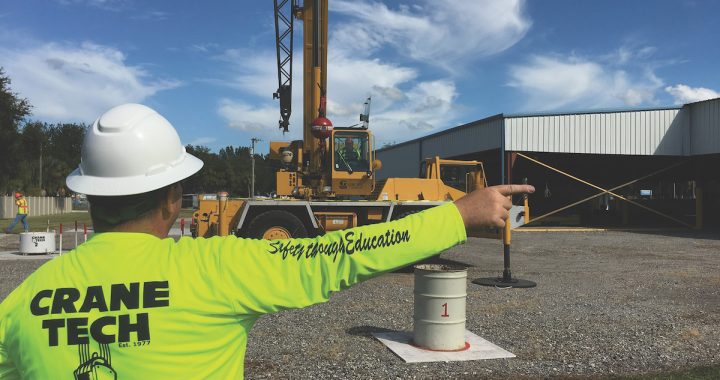PHOTO: Bruce Alexander Signaling – Professional Operator Development training.
Crane Tech: There’s No Mystery to Crane Accidents
PART 1, published in the December 2020 issue of Wire Rope & Sling Technology magazine
by Al Pirozzoli
A framed photograph of President Teddy Roosevelt seated on a greasy Bucyrus Erie steam shovel at the Panama Canal hung prominently on Crane Tech’s founder, Charlie “Doc” Collier’s office wall. What really caught his eye in that photo was Roosevelt seated in the crane wearing his signature white suit from Brooks Brothers. There were many photographs that captured the equipment and men digging out the canal.
However, that particular photo of Roosevelt seated casually in a crane in a white suit caused Doc to realize how many operators out in the field were untrained. That remarkable observation birthed a vision for Doc. With determination to move forward and pursue his intention, he sold his home to raise funds and founded Crane Tech, dedicated to a mission that would stem the tragic losses that plagued the 1970’s workforce.
WHAT THE PHOTOGRAPHS DIDN’T SHOW, SHOWED TOO MUCH
The Roosevelt photograph clearly conveyed an urgency of sorts: the world seemed to be growing fast, and our ambitious nation moved in a frenzy to solve a great world problem, and at no small cost. Doc realized the true cost of the Panama Canal: toiling and injured men, the devastation due to an untrained workforce. These were good men, well-meaning workers but unprepared to recognize the dangers inherent with fast-paced construction activity. These issues of course, were not featured in photographs. Doc’s analysis showed that for every fifty miles of canal length, more than five-hundred workers died. Doc noted that, “We’re talking about fathers, brothers, husbands and young men.”
THE COST OF INEXPERIENCE AND LACK OF TRAINING
Crane and rigging accidents and material losses along with wasted downtime were costing industry billions yearly. Doc’s vision encompassed bringing safety to the people working in the industry through practical education such as recognizing hazards and teaching the skills to work safely and efficiently with equipment.
Doc’s nature could only be defined as people-oriented so there’s no surprise that he worked hard to sustain Crane Tech. His dream of crane operator excellence is a living legacy as the company meets challenges in the industry to this very day.
A VISION IN ACTION BRINGING RESULTS
So many stories catch our attention when they contain substance and authenticity. To that end we interviewed Bo Collier of Crane Tech. Crane Tech was founded in 1977 and Bo joined the company in 1978. For many years Bo worked as instructor and inspector for all types of mobile cranes, overhead cranes, container equipment, forklifts, aerial lifts and rigging gear. In the early 1970s after leaving the Army he went to work in construction and as a mobile crane operator and rigger.
In joining the company, he continued the founding vision and engaged his life-long passion to improve the industry’s excellence. Bo gained his US Department of Labor Maritime Surveyor accreditation for lifting gear certification in 1984 and then as Chief Surveyor in 1990; a position he holds to this day. Bo is a Commissioner for the National Commission for the Certification of Crane Operators (NCCCO). He has served on numerous NCCCO task forces and committees, and sits on the Mobile Crane Written Exam Management committee and the Rigging Management committee.
While Bo remains active in the day-to-day operations which holds his passion, and what he describes as his primary responsibility is ensuring that every service Crane Tech provides is of the highest quality, with an uncompromised commitment to technical accuracy, and efficiency for the end user. We caught up to Bo and posed a series of questions about the industry…
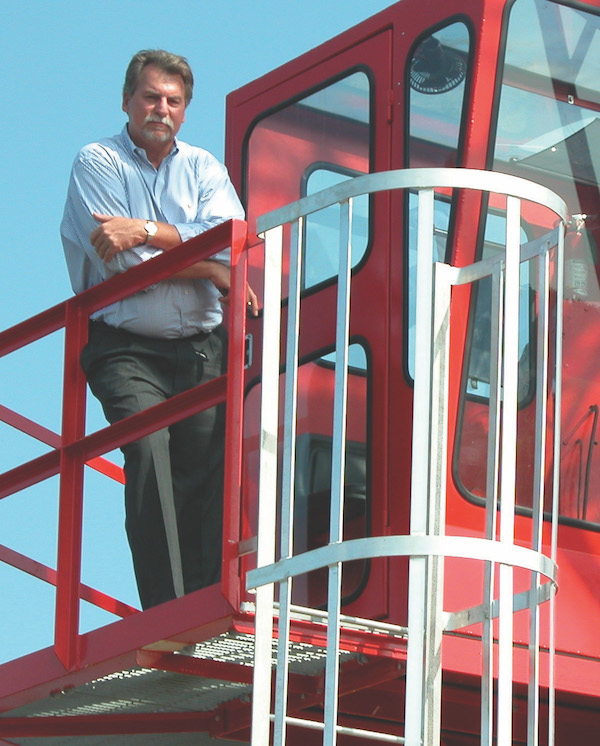
WRN: Compared to how things are done today, what was the crane industry like when you first started:
BO: I’ll begin with a few key factors: Safety measures: I look back now and can see that our managers depended on us entirely to prevent crane accidents. Managers didn’t know much about cranes and were happy to see us get our work done. My experience was one of being taught that lifting the back side of a crane off the ground was okay, so long as you don’t go too far. Fortunately, the equipment manufacturers at that time were producing cranes that could take a beating without breaking or tipping over. In retrospect, we were fairly good at pulling levers, but we had hardly a clue on what we were doing to the cranes.
Operating protocols: I do not recall any formal procedures during the time I operated cranes. This was the mid to late 1970s, and while we never approached a lift or our job as though our safety did not matter, it was a far cry from what we have today. I learned to put cribbing under outrigger pads when on soft soil, but what constituted soft soil was never explained. Neither was there a right or wrong way to put cribbing down. We figured a lot of things out for ourselves.
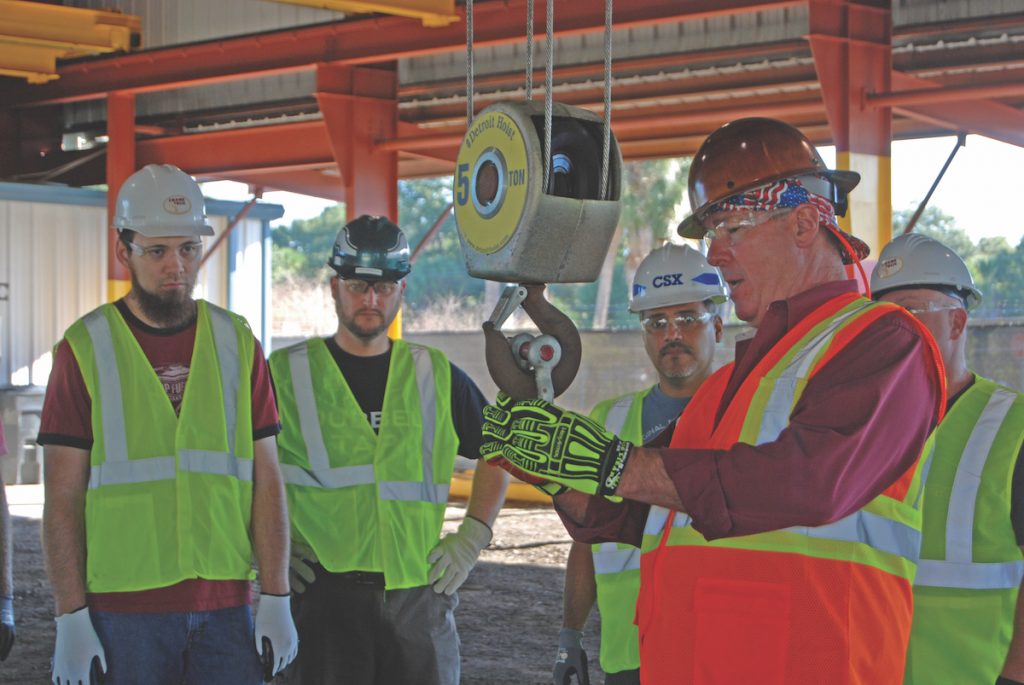
WRN: What do you see as positive trends in your industry?
BO: Over the years crane owners have embraced training, resulting in much better educated operators and giving them the knowledge of what it takes to be safe and work efficiently. The NCCCO has heightened the awareness of certification and training. On the manufacturing side, the crane industry is now building many safeguards into their equipment as well.
WRN: What do you feel are negative trends:
BO: I don’t see too many negative trends, with the exception of outrigger pads. Modern crane outrigger pads are extremely small for the size of the crane. We teach operators that cribbing is required for all lifts unless the crane is set up on a very thick concrete surface.
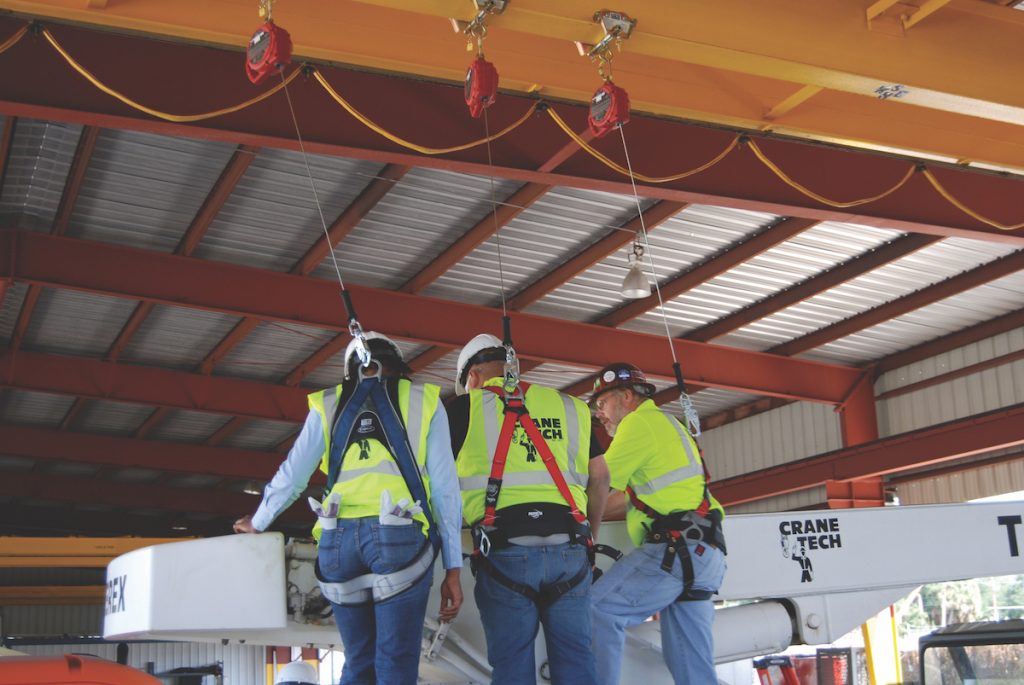
WRN: Are field training classes held onsite, in the field, or at a client’s location?
BO: Most of the training we provide is on site at a client’s location. In all cases, there is a certain amount of technical classroom training required before you can go into the field. While hands-on training is a critical element, we have to make sure the participants understand certain regulations and manufacturer’s instructions beforehand. We also have a training center in Tampa Bay where we have scheduled training classes including our very popular Professional Operator Development (POD) for inexperienced operators.
WRN: What would you say customers like best about your business?
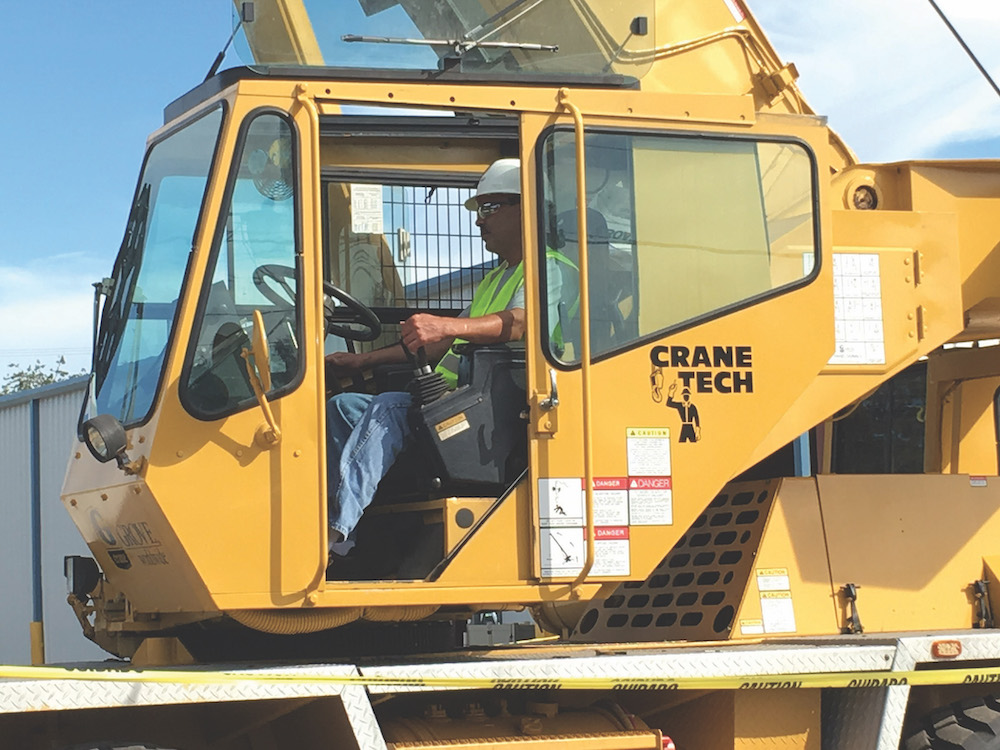
BO: The knowledge and professionalism of our instructors is the most common remark we hear. Many of the students at our Tampa Training Center are inexperienced. Customers have told us that we really seem to care about them and help them get certified to be able to do well in their careers as crane operators.
WRN: What would you say customers like least about your business?
BO: I queried my instructors on what they believe is the least thing customers like about us. The response was overwhelmingly, the price of service. Training is an intangible product and difficult to compare until after the fact. One instructor said he has heard customers say how expensive it can be to hire the wrong training company. So, I think we hit a good middle-ground.
WRN: What, if any, are the most common problems that your customers deal with in training sessions?
BO: Many times, managers are unaware of exactly what the problem is, they just know they are having incidents, or accidents, and they need to correct it. From a management side, scheduling training around employees’ work requirements can be costly for the client—significantly more than the cost to bring us aboard for training.
WRN: What types of machines/instruments do you use when training out in the field?
BO: We have several dynamometers (crane scales) we use both at our facility and in the field when doing rigging training. We also have cases and boxes of rigging gear, hardware, and testing kits that we ship to clients as needed.
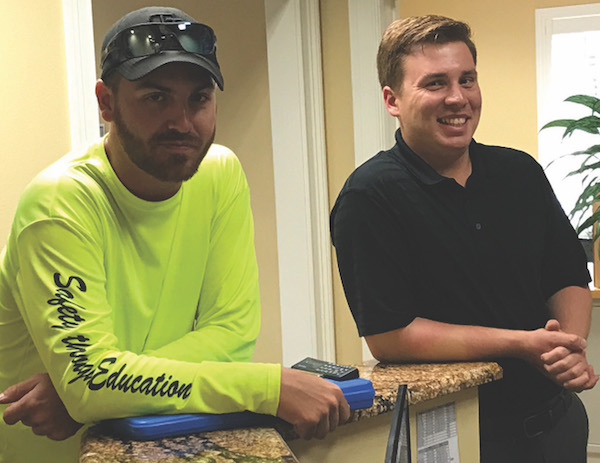
WRN: Do you make use of virtual training simulators (and what kind)?
BO: We do not use simulators. Originally, simulators were an easy and less expensive means for companies to give operators a hands-on experience without the large investment required for actual cranes and a place to operate them. Crane Tech has not chosen to stay away from simulators as much as we have decided to invest in actual equipment. I see all the hype and articles of simulators being used to train crane operators, and I have used a few at trade shows.
But I have my doubts that simulators, at least in the scale currently in use for crane operator training, can supplant the actual seat time an operator needs. A couple of years ago I had the opportunity to visit the Maritime Institute of Technology and Graduate Studies (MITAGS) in Linthicum Heights, MD where I was given a tour of their Maritime Navigation Simulator. With this simulator you walk into a full-size ship’s bridge, loaded with actual navigation equipment and controls. The simulator produces a panoramic view of waterways, other ships and bridges out each window that is projected onto a large geodesic dome. Just as I was getting comfortable taking it all in the instructor changed the sea state and lightening starting cracking and you had to hold on to your stomach, or at least the console near you. This simulation was a full emersion, unlike the feel I got from a large computer screen and a joystick controller. This is a multi-million-dollar investment that is simply outside the reach of most small business.
We also have to consider that our business is split into two divisions, where one side spends all of their time at our client’s worksites teaching and coaching operators using the client’s cranes and equipment. Then we have our seminar side where people and companies come to our site for scheduled training programs. We have invested hundreds of thousands of dollars in equipment, a large training site, support equipment, and people to keep it all maintained. We believe this is the best for our customers – even though the same investment would buy a lot of simulators. WRN: Can you tell us a little bit more about “Course Builder” and how does that benefit the trainee?
BO: Course Builder is a propriety learning management system (LMS) database that Crane Tech created starting in 2005. Course Builder is essentially a Sequel Server database that interacts with every facet of our training. We contracted a programmer who worked on the project until his retirement this year.
Course Builder benefits our students and clients by formalizing our creation of learning objectives, allowing specific exam and workshop questions to be written to specifically address these objectives, then by analyzing the results of student testing to tell us how well we are conveying the training subjects. We use bubble cards for students when taking our exams. Exam answers are scanned into Course Builder and analyzed against thousands of similar candidates and responses. We create exams by adding questions to a list of learning objectives. Instructors teach to the objectives and the exam measures achievement. Course Builder also keeps track of all training documents assigned to clients so we can repeat any course at any time by any instructor. Course builder stores learning objectives that are used for the creation of a detailed syllabus, so instructors always stay on topic.
WRN: What would you say is the primary advantage of Course Builder?
BO: The real benefit to our customers is our ability to quickly build a customized training solution that is proven effective. We created document nomenclature that ensures we never forget to add something to a course. It can get a bit complex to explain, but the end result is consistency and repeatability. I could go on and on because Course Builder is integrated into every part of our business. Customer information, student data, test questions, learning objectives, documents, training manual development, and so on.
WRN: What is the turnaround time from class to being on the job?
BO: This depends on the client and their employees. If we have an instructor available we can turn around in a day or two.
WRN: What would you say that employers look for in potential crane operators of the future?
BO: As far as what we or employers look for in potential crane operators, I think we are all looking for personnel who accept learning, to embrace new equipment and features, and to apply safety measures proactively. I believe everyone wants personnel that will work as a team.
WRN: What if any, are the prerequisite requirements for your training?
BO: Prerequisites for training vary, depending on the types of training required. The most common prerequisites relate to rigging. It’s unrealistic to expect any lasting achievement from the time spent in the advanced training if the basics are not yet mastered.
WRN: What hazards do new students run into most often?
BO: If by hazards you mean obstacles, then I would say that most new students have no idea of how important the standards and regulations are to the safety of their operation. This has always been the case and students will readily admit after training how important the standards are. If by hazards you mean risk, then I would say that is complacency. Some cranes are easily operated and operators that don’t stay focused on the job at hand can be lulled into a complacent state that is ripe for disaster.
WRN: What are the most difficult tasks that the students face in class?
BO: This is very much dependent on the training. For mobile cranes it’s load charts. For rigging it is the math.
WRN: Is there ever a case where a student just does not have what it takes?
BO: Yes, but it doesn’t mean they can never make it. For some new crane operators getting the feel of the crane and learning to control load swing comes easily. For some this coordination comes at a slower pace. It is a complex combination of having the right amount of confidence with good eye-hand coordination. Get too confident and you can get into trouble quickly, lack confidence and you cannot get any work accomplished.
For more information about Crane Tech, visit their website www.CraneTech.com
Read Part II of There’s No Mystery to Crane Accidents


